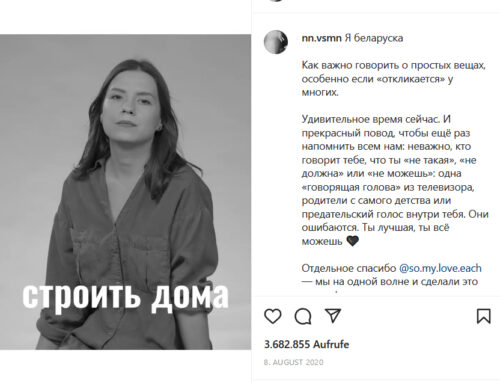Terrorist propaganda is finding wider distribution due to the technological possibilities of the digital age. Terrorist organisations such as the Islamic State are increasingly using Web 2.0. for propaganda purposes and to mobilise potential supporters. In the following, the extremist propaganda video No Respite will be examined in terms of its aesthetics, its possible impact, and its way of addressing the audience.
No Respite is a jihadist propaganda video produced by the ‘al-Hayat Media Center’ on behalf of the so-called Islamic State (IS) and was released on 24 November 2015 on a variety of video platforms, including YouTube and Liveleak. As is usual with extremist clips, the video was removed after a short time due to violation of the terms of use of the respective platforms and reappeared, uploaded under a new name and from other accounts, on various sites. Since there is no centralised IS platform and thus no ‘official’ upload, the number of hits and comments varies greatly.
The video shows a series of rapidly changing animated graphics that outline the historical, military, political, and religious dimensions of the war of the ‘West’ against the ‘Islamic World’ – culminating in a vilification of the United States and a direct appeal to wage war on the ‘coalition of devils’: ‘Bring it on – all of you!’ The video begins with a comparative overview of the power and extent of the ‘Khilafah’, the territory that the I.S. declares to be the ‘Caliphate’, covering an area that is already larger than the whole of Great Britain, according to the off-screen voice in perfect English. The Western secular state, its legislators, and actors whose interests are defended by the soldiers of the West are visualised, portrayed as a negative foil. This is followed by portraits of Obama, Bush, and Clinton, who in increasingly drastic language are called ‘legislators’ (alluding to the imperfection of human versus divine law), ‘liars’ (alluding to Bush’s justification of the Iraq war) and ‘fornicators’ (alluding to Clinton’s extramarital affair). Footage from a special session of the UN Security Council on the persecution of homosexuals by the IS is also commented on as a depraved interest in fighting ‘for the freedom of sodomites’.
After the ‘West’ has been broadly portrayed as the enemy in this way, a contrasting, positive picture of Islamism follows: masculinity, religiosity, and unity are elevated to the premises of military strength and successful resistance, praising a heroic rejection of the existing, Western-style system. This is followed by a commitment to ‘Tauhīd’, the belief in the unity and uniqueness of God, against the strongly negative counter-term ‘Schirk’ (‘idolatry’), which is purified by the religious zeal of the IS fighters in a symbolic blaze of flame. The video also criticises the ‘nationalism’ that divided the Arab world after the collapse of the Ottoman Empire and, according to the implicit assumption, led to oppression and division through the Sykes-Picot Agreement. The underlying friend-foe dynamic is underscored by adherence to a consistent visual concept: the image of Western politics as the enemy is always underlain with a black background and a dark cloudy sky. The literal darkness is then broken by bright, light-flooded images of IS soldiers. The goal of undertaking the jihad legitimised by God ‘united under one flag’ – under the banner of the IS – is thus glorified, while the crushing of nationalism and the destruction of ancient sites of polytheism such as Palmyra and Hatra, represented by seas of flames and dusty heaps of rubble, is glorified as the only true consequence.
The idea of belonging is also intended to be propagated with cleverly chosen photo inserts. Standing next to each other, arm in arm, four men of different skin colour, but all in military uniforms, smile into the camera. Only unity and justice before God in the name of Shariah, the divine laws, count, according to the tenor of the video. Origin and personal background play no role: ‘There is no difference between an Arab and a non-Arab’, it says in a side blow against the latent racism that seems to be imputed to the American population, ‘between a Black and a White’, adding: ‘except through piety’. Age is irrelevant, too: young boys and teenagers pose, Koran and assault rifles in hand, in front of the waving IS flag as army recruits.
This glorification of their own mission and their followers is in turn replaced by a vilification of the ‘enemy’: the American army is portrayed as a numerically superior, but morally broken group of indecisive, suicidal, and mentally and physically weak people. The speaker suggests that the US Army is falling apart from within, even before it has begun to fight the IS warriors – and it is also wasteful and economically inefficient. Without naming any sources, diagrams are used to ‘prove’ the costs of the ‘war against Islam’ and thus against ‘the’ Muslims. For example, a US missile worth $250,000 is contrasted with a 50-cent bullet, implicitly suggesting: ‘We’ are fighting as efficiently as you are. In a further intensification, the coat of arms of the Combined Joint Task Force (CJTF) is shown – only to be dismissed as a ‘coalition of devils’ – together with flaming portraits of the head of government of Iran and the heads of state of Russia and Turkey. A direct challenge to the anti-IS coalition follows: the international front against the IS exists only because the ‘Millah of Kufr’, the army of infidels, will always unite to fight the truth. ‘Your strength in soldiers’, it is further said, ‘only increases our faith.’ The speaker paraphrases a prophecy of Mohammed from the Quran and interprets it as a guarantee of victory against the coalition, symbolised by a grid of flags: When the number of enemy nations has risen to 80, there will be a fiery final battle at the northern Syrian city of Dabiq, where the Muslim army will meet the enemy.
We are challenging you is the message at the end, while a soldier posing broad-legged in front of the waving black IS banner points directly at the audience, breaking through the fourth wall. As the image slowly zooms out from the initial close-up, the speaker challenges all enemies to conspire against the IS and grant it ‘no respite’, no delay, no time limit and no waiting. Because, as the voice accompanied by thundering echoes proclaims: ‘Our ally is the greatest, he is Allah.’ Finally, the 10th Sura of the Quran (Yunus 10:71) is faded in, accompanied by prayer chants, which reaffirms that the enemies may conspire and put their plan of attack into action ‘without respite’. The element of martyrdom is emphasised here not only by almost paradisiacal calm, but also by the determined, self-confident provocation of the ‘enemy alliance’.
The special effectiveness of the propaganda video is based on its professional high-gloss aesthetics – like most of these clips, it is produced in Full-HD quality and 16:9 format. The resemblance to first-person shooter computer game aesthetics is also a deliberate stylistic move: the rapid succession of animated maps, figures, flags, and logos is remotely reminiscent of the ‘mission briefings’ in modern military shooters, for example. The aesthetics of the ‘cool’ operation with the flair of a thrilling, action-packed combat mission is chosen for a reason, as it is meant to be extremely attractive for young people. Wolfgang Schmid describes this tendency as the development of a new ‘counter-culture’, in which the games industry and the influence of the internet, among other things, mixes with the ‘ideology of militant Islamists’. [1]
The video’s heroic pathos is enhanced by an apocalyptic atmospheric sound track, an impressive speaker’s voice, and encouraging male choruses. The motivation is clear: to reinforce morale and cohesion against a common enemy – the West and its allies, and especially the United States. In contrast, the IS is shown to be an emancipated heroic organisation that stands up against generalised ‘evil’ in the form of an inefficient international military alliance and the values it represents.
The recourse to stereotypical role models and idealized archetypes – primarily bearded, broadly built, and determined looking soldiers – is central to the self-dramatization of the IS and its fighters. In this way, the Islamist who is ready to fight presents himself as a prototype of the alpha male and as a model that is intended to appeal to and potentially mobilise young men, especially those who have been socialised in the West.
The viewers are not only expected to have a specific level of knowledge. The video is also intended to make them subliminally engage more closely with the goals of the so-called Islamic State and to understand the historical background, motivations, and justifications of the struggle. However, the video’s appeal is not only directed at potential recruits and sympathizers, but especially at the international community and its armed forces. It calls on them to confront the I.S. in battle ‘without respite’ in order to conjure up the prophesised final battle.
Sami G.



